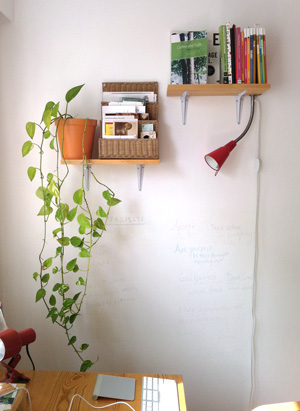
I’m very pleased to announce that in addition to my home office, my website is now bullfrogpowered® with 100% green electricity thanks to Ethical Host. It’s just one of many ways I walk the talk. To help you make a difference at work, here are nine tips to make your home office more earth-friendly.*
1. Use a chalkboard for ideas, to-dos and notes instead of paper. I like having my to-do list or projects list in front of my face, but I grew tired of managing scrap paper and rewriting notes when they got messy. I also wanted some motivational quotes nearby that I could change at will. Paint a chalkboard wall or board with VOC-free latex paint — available from Benjamin Moore in any colour — and use real chalk, not chalk pens. Wipe it off with an old sponge or a rag, rather than paper towels. Chalkboards are great for being non-committal. Get different colours of chalk to colour-code projects on a hand-made calendar, which could be a temporary or permanent feature.
2. Bullfrogpower your pad (if you know how much energy you use) and use energy-efficient lighting (LEDs or compact fluorescents). My monthly Bullfrogpower fee is less than $2, or about 10% of my electricity bill, but all of us together really adds up to a big positive impact! If you can, position your desk to take advantage of natural light. If you can see out a window, even better, so your eyes can get a break.
Continue reading 9 ways to green your home office »
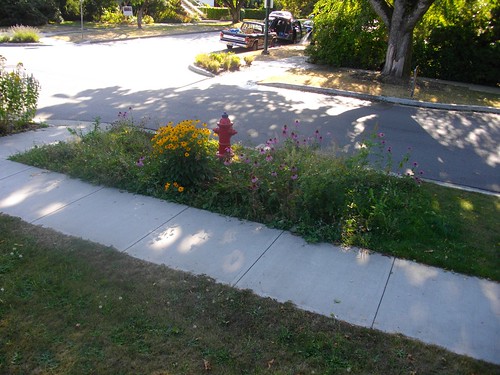
The garden is greener on the other side of the road. (Photo by
urbanwild via Flickr)
I thought I’d alert you dreamers, makers and thinkers to some upcoming events in Vancouver.
This should be an interesting month, with David Owen speaking Thursday on why Manhattan is the greenest city, and if Portland isn’t, Mark Lakeman is sure to prove they’re ready to take the lead.
“Eco-Dreaming Vancouver!” with Mark Lakeman, City Repair Co-Founder, Portland
Friday, March 25, 7:30pm – 9:30pm
Join us for Mark’s “The Village Lives” presentation on how Portland is rapidly becoming the USA’s leading green city!
Saturday, March 26, 10am – 5pm
Join us for a day of Collaborative and City Repair Games facilitated by Mark Lakeman, Power of Hope and Village Vancouver. We will spend the day building community, having fun, and learning how to work as “villages” to ecologically re-design and retrofit our neighbourhoods. Registration 9:30 am. Please RSVP for Saturday workshops to: sara[at]powerofhope.org
Location: W2 Storyeum, 151 West Cordova
Cash bar and lunch service available by W2 Catering.
More information and register by donation at ecodreamingvancouver.eventbrite.com
Thanks to Sara Dent.
Continue reading Upcoming: Mark Lakeman, Natalie Purschwitz and SUSTAIN: Vancouver »

Photo by
Snurb via Flickr
While searching for articles more in-depth on the first issue here, I came across some interesting finds. If you can read between the lines, you’ll figure out my headline. (Unintentional cheesy rhyming.)
The nuclear plant explosion caused by Japan’s magnitude 8.9 earthquake, and potential of further danger, reminds us just how risky and costly nuclear power is, says Greenpeace. Writes Ariel Schwartz for GOOD, “Nuclear power plants aren’t cheap, either. Reactors cost billions of dollars to build, which is why there are only 104 operating in the entire country [US] and why they’re all old — all of these plants began construction in 1974 or earlier.” And I think we can all agree a wind or solar farm is far more attractive than a nuclear power plant. Speaking of solar farms, this farmer is harvesting the sun along with his wheat.
Continue reading What do climate change, farming and hipsters have in common? »
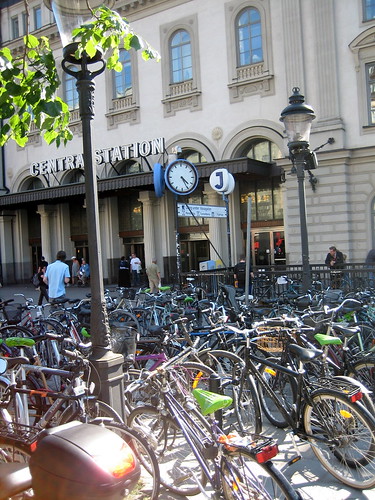
Bike parking at Stockholm Central Station. (Photo by
EURIST e.V. via Flickr)
I read quite a great article about Stockholm’s sustainable qualities last year and can’t find it, but here are some interesting new-to-me tidbits I dug up tonight:
This is awesome: the 250,000 or so people passing through Stockholm Central Station every day generate a lot of heat, and one Swedish company has figured out how to harness the otherwise wasted energy to heat a nearby building. The system “lowers the energy costs of the office block by as much as 25%.” (Via GOOD)
Hammarby Sjöstad, formerly a run-down industrial area in Stockholm, has been undergoing a metamorphosis since the early 1990s that has made it a model of sustainable urban development. From waste and wastewater management to renewable energy and active transportation, the community has an integrated plan with strict requirements and ambitious goals. GOOD talks about the community’s use of distributed energy, and it’s pretty exciting stuff.
Check out this Green City Guide on Stockholm’s other offerings, like a green hotel chain and organic treats, clothing and cosmetics.
 This daily green blog challenge is in celebration of David Suzuki’s 75th birthday, supporting the David Suzuki Foundation. Please support our work on climate change and safe cosmetics by making a generous donation online now.
This daily green blog challenge is in celebration of David Suzuki’s 75th birthday, supporting the David Suzuki Foundation. Please support our work on climate change and safe cosmetics by making a generous donation online now.
Note: I am writing solely on my own behalf, and do not claim to represent the David Suzuki Foundation or its views here.
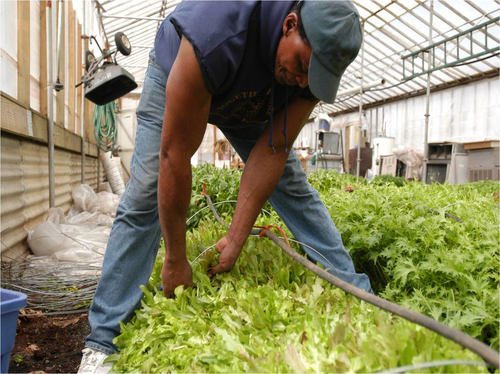
Will Allen harvesting (Photo credit: Growing Power)
Back-to-back films on agriculture at the World Community Film Festival this afternoon left me uplifted and feeling like change is on the horizon. Dirt! The Movie, Fresh and A Thousand Suns reminded me how many people there are who think like me — including those attending the event — and what amazing impacts these people are making around the world.
One farmer in the US took it upon himself to build a wind farm on his farm as security for survival. (Actually, I think that was part of Dirty Business, a film about coal and energy which followed. I saw four films in 6 hours, so please forgive me if I confuse them.) Will Allen, a former basketball player, returned to his family’s farming roots and started Growing Power, where compost is everything. Joel Salatin is a farming hero, Michael Pollan speaks the truth in terms people can understand, schools are tearing up asphalt for gardens, and rehabilitation programs for inmates are reconnecting people with the land.
Continue reading Fresh Dirt! »

El Naturalista (left), Simple sneaks
I’m going to start with the caveat: you cannot buy your way to sustainability. Consumerism is one of the major players in our swift and accelerating destruction of the planet. That said, when it comes to essentials, you’re unlikely to walk barefoot year-round in Vancouver. I’ve also included some non-essentials, although that depends on how much you love your iPhone. And making it look cool. That’s a fair quest in itself.
Also, when I say eco-friendly, I mean eco-friendlier, but I digress. So, in no particular order…
1 & 2: Green shoe, red shoe…
Oh-ho yes… eco-friendly shoes. This is for boys and girls. I wasn’t a shoe chick until I discovered Simple and El Naturalista. Simple has your sneakers, sandals, and boots in biodegradable, natural materials, including recycled tire tread! They’re not 100% perfect, but it sure beats plastic and other synthetics. (Cotton shoelaces!) Whether you’re a yoga mom, skater, hippy or hipster, these aren’t your hempy frumpy shoes of Woodstocks past. El Naturalista is higher-end (fancy-shmancy) but exquisite quality, offering a variety of juicy-coloured leathers. (Excuse me while I wipe the drool from my chin.) Before you take me to the cleaners on promoting leather here, I know that not all leather is treated equally, let alone the cows. Just consider where the fake leather (like vinyl) comes from. Spain’s El Naturalista, says their website, “seek out production processes that are eco-friendly and promote traditional craft skills, we utilize natural materials and dyes, we avoid toxic products and materials, and we practice conservation by using substances that are biodegradable and recyclable.” So while you tread lightly, you can also feel better about yourself. Plus they’re hottttt. The box for my shoes throughtfuly included a drawstring reusable bag to carry the box. (Oh my god, 25% off right now… no no, don’t need more shoes. Shush, Erika.)
Your second-best option? Ask for 100% rubber soles — they have a stickier grip to help you distinguish from the fakes, because the symbol is the same. I’ve been told something’s rubber when it’s clearly a composite. Other great shoe materials are cork, wool and organic fabrics. I’ve seen wood, but I don’t know how ergonomic it is. Take care of your leather using natural silicon or wax instead of harmful sprays.
Continue reading 5 green companies you should know about for things you didn’t know you could green »
Today I found myself feeling embarrassed that I reacted to a stranger’s not-eco-friendly act with something that, although gentle, ultimately got me nowhere because it got her back up. Despite my best attempts to be casual and compromise a little, I still made her feel like she’d done something wrong. It’s possible she didn’t know any better, or, I conceded to her, that she may not have the resources in her community. But I think I would have been better off asking, “You don’t have any recycling or donation facilities nearby, or none of your stuff was salvageable that way? That’s too bad!” Maybe it still would have come off as a criticism but at least it may have been more directed at her town instead of at her. Nobody likes to be questioned that way, and I always feel terrible if I think I’ve hurt someone else’s feelings.
It’s a sticky thing, having conversations that essentially challenge the way others live, whether it’s your own sister (I’ve failed pretty miserably at that), a friend, or a complete stranger. I’ve felt bad after casually saying, “No fat yogurt? That’s no fun!” to a friend, and it’s really hard to approach people about their synthetic fragrances because they’ll take that very personally.
Continue reading How do you talk about people’s (not so) green habits? »
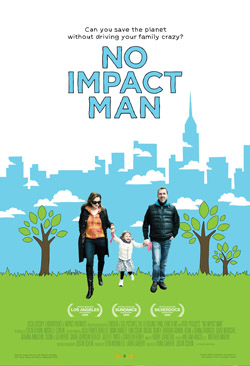
It’s a familiar pattern now: Alisa Smith and James MacKinnon ate locally for a year and wrote a book about it; Jen and Grant went zero-waste for a year, blogged and filmed a documentary about it. If doing either of those things doesn’t seem crazy and transformative enough, Colin Beavan’s family of three did both for a year, and turned off their electricity (for 6 months), self-powered their transportation, went vegetarian and stopped using toilet paper. The project, No Impact Man, is a film, a book and a blog about eliminating one’s personal impact on the environment.
The point of doing something this extreme, he cautioned, was not to suggest that everyone do it, but that everyone can do something. Individual actions, he says, inspire and engage others to act. That’s the power of community, something he says has eroded. It’s also a challenge to us to consider what really is necessary for daily life and what we could do without. As Colin puts it, living with a low impact is about “doing more good than harm.” At the end of their year, Colin’s wife Michelle decided she’d like to keep cycling (something she’d never have considered a year earlier) and not bring back their TV — except on vacation.
Continue reading Film review: No Impact Man »
I realised when I left Pecha Kucha (at the gorgeously renovated Queen Elizabeth Theatre), in a hurry to catch my 10:20 bus, that I don’t have enough conversations with people about sustainability. I attend events where the hundreds or thousands of people in the room/theatre all have a common interest, yet I go there to absorb information, chat with friends and promptly leave. I can’t blame all of that on living in the suburbs with a typically once-per-half-hour bus. But ultimately the result is that the information I gleaned and my opinions remain for the most part locked in my head and I lose the opportunity to learn from others in my community. (And Vancouver being a small city nurses an intimate though often disconnected one.)
Dialogue takes place frequently online, but in my experience it tends to be short and superficial and, while offering participation theoretically to anyone, the reality is that many voices are left out even within our own city. That’s where dialogue in person can facilitate those deeper connections that might not otherwise be made. It also lets us communicate visually. (And with that, check out RangiChangi Roots.) An event like Pecha Kucha is available to anyone with $10 and a couple hours to spare. It won’t reach everyone, but advertising in offline and particularly free media such as the Georgia Straight (I’m not sure whether it made it to street poles) pushes its reach outside of the—to some degree—exclusive online world. Over 2000 people attended Wednesday’s event, a specially-themed “Walk the Talk, Green Your City”, which is terrifically encouraging.
Continue reading Walk the Talk, Green Your City »
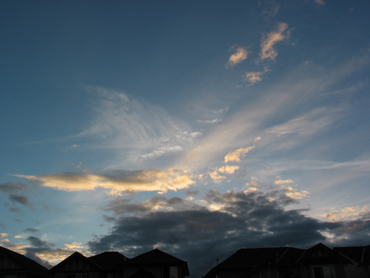
Feeling inspired, I’d like to start a meme on what actions you’re taking, or planning to take (a pledge!) to help the environment. This is a broad-reaching scope, and encompasses anything and everything: choosing organic food, taking transit, composting, donating to an environmental organization, recycling unwanted goods, installing solar panels, or even just educating yourself on issues and solutions. Is there a particular action that tops your list? Or one you’ve been eager to try?
For brevity’s sake we’ll keep the list to 10 items. You can divide it up between “doing” and “intend to do” in whatever ratio you like.
So here’s my list, in no particular order:
Right now, I:
1. Eat local
2. Use cloth bags and compostable plastic bags
3. Advocate for revival of the Interurban community rail
4. Reduce, reuse, recycle!
5. Use strictly natural cosmetics and soaps, with recyclable packaging and no chemicals
6. Use strictly natural cleaners (baking soda, vinegar, water, the occasional lemon)
7. Use a reusable stainless steel water bottle
I will:
8. Reduce waste by switching to Lunapads products (they’re local!) — immediately
9. Live in a walkable neighbourhood with frequent, accessible transit — 2 to 3 years’ time
10. Buy a cradle-to-cradle, toxic-free sofa made from natural materials — 2 to 3 years’ time
Continue reading 10 things you’re doing/will do for the environment »


 The garden is greener on the other side of the road. (Photo by
The garden is greener on the other side of the road. (Photo by  Photo by
Photo by  Bike parking at Stockholm Central Station. (Photo by
Bike parking at Stockholm Central Station. (Photo by 
 Will Allen harvesting (Photo credit: Growing Power)
Will Allen harvesting (Photo credit: Growing Power) El Naturalista (left), Simple sneaks
El Naturalista (left), Simple sneaks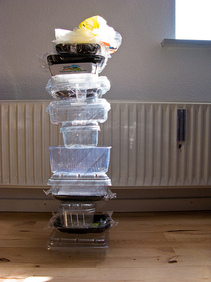 Photo by
Photo by 
